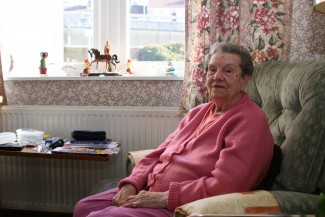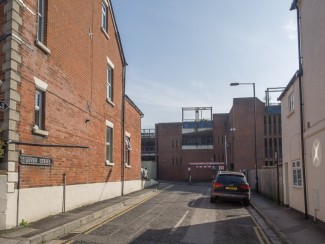8. Walking Culver Street

The Street
Culver Street was one of the original mediaeval streets of Salisbury. In the Middle Ages, it was part of Salisbury’s ‘red light district’. It is recorded that in 1452 the women scandalised the citizenry by neglecting to wear the striped hoods prescribed as their official dress and the City Fathers ordered them out of town.
By the 19th and early 20th centuries, it was a residential street, rather like Guilder Lane, complete with small shops and a pub. By the early 1970s, most of the street was demolished for development associated with the Ring Road – hence today’s dominant feature, the car park.
Margery Bodger, born in 1921, lived all her life in No. 40 Culver Street until it was demolished to make way for the car park. Listen to a childhood memory of her’s in the audio clip on the right side of this page or in the MP3 from the Downloads page.
Entrance To The Street
The only original part of Culver Street which survives today is the side entrance to the corner shop at No 68. Milford Street. Here, there was once a row of six small almshouses run by St. Martin’s Church. They accommodated six elderly women who each received a weekly gift of three shillings and sixpence from the Church.
Walk on to the car park and then left round it by the tarmacked footpath. Go under the archway on your left into the car park of block of flats Nos. 12-18 Culver Street. Walk as far as the ‘No Ball Games Sign’.
View From The Car Park
From here you can see the volume of traffic on the Ring Road, which occupies what was once the west side of Rampart Road. Both the inhabitants of Culver Street and Rampart Road were evicted out of the homes their families had lived in for generations, to make way for the Ring Road.
The ‘Invicta Leather Works occupied most of the space taken up by the houses on the far side of the car park It was dominated by a tall chimney and was a major Salisbury industry.There is more about this at the next Stand.
Go to the end of the street to the junction and turn left into Paynes Hill and view the modern houses on your left which occupy the site of the Invicta Leather Works. There is little to see here nowadays, but the text accompanying Stand 9 reveals a little of what life was like here before these houses were built.



Comments about this page
There was a girl who lived across the street from us who was always coming round trying to sell things and Mum for some reason bought a small wooden sledge from her. There were no hills within miles of us and we didn’t have a car. No one did, I think, for the road was always completely empty – cars didn’t even drive down it very often by the time we moved in – which was about 1967.
So we ended up with an ornamental sledge.
The sledge followed us to Crawley when we moved in 1969 and I remember using it to carry cans of paraffin back home through the snow so we could heat the new house more cheaply than using the gas fire. So I suppose it worked out in the end…
When we first moved in, next door (either number fifty or number forty six) was empty. We all climbed over the back fence, went in through the unlocked back door and had a look round. It was much the same as our place. There was a pile of junk mail under the letter box, including free samples of blancmange, jelly and suchlike which we took home and ate. I remember none of us thought they were much good but free is free and it saved us buying supper.
The people who eventually moved in had two daughters about our age and a mynah bird with a decidedly sardonic turn of phrase.
Mum told me years later that we were given the house rent free (imagine that these days) I suspect the ‘landlords’ just wanted people in the place so it couldn’t be squatted, which would have been a real problem at the time, squatters then being very hard to evict and the owners (who by that time might even have been the council themselves) were waiting for the council to demolish everything and build the ring road extension they’d set their hearts on.
Also, the electrics went back to the nineteen thirties, bakelite switches and fabric covered leads and flexes if I remember rightly. I suspect by that time the houses weren’t deemed fit for human habitation. Unheated, ancient electrics, no bathrooms, etc etc.
Anyway, the whole area was demolished a year or so after we left and a road was built across the flattened site. However, the council either ran out of money or changed their minds because it was never finished. The main feature was an overpass – an elevated stretch of road – that was abandoned halfway and stood for years unused and useless in the middle of the waste ground that had been our neighbourhood. It was apparently known locally as the diving board, which was exactly what it looked like.
So, Mrs. Bodger lived four doors down from us. I don’t remember much interaction with any of our immediate neighbours but do recall going to play with a friend across the road who lived in a comparatively new house, presumably built in the early 60s at the latest. Even with my limited knowledge of urban housebuilding at age four I realised that his house was of dreadful quality – holes had been either kicked or punched in the plasterboard walls and nothing felt stable. Our bathroom-free Victorian pile seemed a much more desirable place to rest your head of a night. Before moving to Culver Street we lived at 96, Exeter Street. My bedroom had an uninterrupted view of the cathedral spire. We rented the house from the Roman Catholic church next door. Canon Hyland would often come round with a packet of N°6 and bottle of altar wine to share with my parents. We liked him enormously and he didn’t mind us not being Catholics. I was fascinated by his Irish accent, it seemed very exotic at the time.
We lived at 48, Culver Street in the late 1960s. It was a three-storey Victorian townhouse. you entered directly into the sitting room, behind which was the dining room and two steps down, a large kitchen with a walk-in larder. There was an outside loo. The garden gave on to a metal dump – full of old ice cream tins from the ice cream vans – the back wall still housing the original outhouse. There was no bathroom, we had a tin bath we set up in the dining room and filled with hot water that my grandmother heated up on the kitchen stove. The first floor had a front and back room, intersected by the staircase. At the end of the next flight you had the same arrangement.
I have very fond memories of my time in Culver Street, walking home from Saint Martin’s Infants just a few minutes walk away. There was a lollipop lady who saw us across the dual carriageway, the pedestrian underpass was built after we left.
Thank you for your lovely memories!
Thank you, great article. I LOVE to read about these older places / times, but it’s also sad the buildings have gone, as usual to make way for the ugly – ‘evicted out of the homes their families had lived in for generations, to make way for the Ring Road.’ – This isn’t ‘progress’, it’s going backwards; making life quality worse instead of better..
So glad to hear you are enjoying the website! Thanks for sending in a comment, we love to get them.
As you entered Culver Street from the northern end, on your right was a small corner shop selling groceries, the owner of this shop was Mr Ralph. After passing a row of terraced houses on the eastern side of the street there was an arch built into the houses with rooms above it. Inside the arch was a steeply inclined roadway that led to the dairy, the larger lorries could not turn into the arch in one go and had to have two attempts at turning, the house opposite the arch bore the scars of vehicles that had failed to stop in time on the backwards roll of the turn. Early mornings in this area were very noisy with the milk floats setting off followed by lorries loaded with empty milk churns being hit by the chains that held them on. In case anybody managed to sleep through this dawn chorus, Fosters Bakery on the other side of Milford Street had a large fleet of vans that needed loading up and sending on their way.
Past the dairy on the eastern side of the road was a block of six three-storey terraced houses, I lived in one of these for a few years (No. 53) the back garden was a forty five degree slope with the dairy office block at the top resembling a concrete railway carriage. Putting washing out in this house entailed taking it up to the first floor and opening the landing window which gave access to a clothes line running around a pulley and attached at the other end to a post at the top of the garden slope, the washing would be hung on the line and then fed along by pulling the other side of the line.
Further along on the western side of the road was a block of comparatively new old people’s flats with an area of grass in front of them, opposite these flats was a closed down pub and a row of house, some empty and some occupied. On the corner of Barnard Street was The North rubber Co. What happened in this building i never found out but the man that ran it needed lots of cardboard boxes for which he would pay one old penny a piece. One entire school holiday was spent transporting waste boxes from the dairy to this nice man who after a week was starting to vanish behind a sea of boxes. My word I ate a lot of chocolate that week!
Add a comment about this page